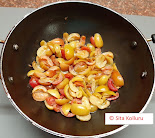- 1 bunch fresh or frozen methi leaves ( Fenugreek)
- 1 cup fresh sweet corn
- 2 medium tomatoes, diced
- 1 large onion
- 3 Teaspoons oil
- 1 Teaspoon red chili powder
- 1 Teaspoon garam masala
- 1/2 Teaspoon jeera powder
- 1 Teaspoon jeera seeds
- Salt to taste
- Wash and clean methi leaves.
- Discard the hard stems.
- Chop the leaves coarsely. (About one to two cups)
- Shred the corn ( About a cup)
- Clean and dice the onion.
- Dice the tomatoes.
- Heat oil in a thick pan.
- Add jeera seeds.
- Add onion and stir well.
- When onion pieces turn translucent, add shredded corn.
- Stir well.
- Cook for 2 or 3 minutes.
- Add half cup water.
- Add methi leaves. Keep stirring.
- Add masala ingredients.
- Add more water according to taste.
- Cook for 4 to 5 minutes.
- When the corn is soft to touch, remove from heat.
Note:
If methi (fenugreek) leaves are not available, the same recipe can be made using any green leafy vegetable like Palak or spinach etc. Before removing from heat, a spoon of Kasuri methi (dried methi leaves) can be added. Rub the kasuri methi in your palm and add the powder to the subzi. Cook for a minute.






































